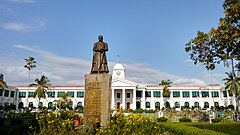Kerala Government Secretariat
| Government Secretariat Building | |
|---|---|
| കേരള സർക്കാർ കാര്യാലയം | |
 |
|
| Former names | Huzur, Puthen Kacheri |
| General information | |
| Architectural style | Roman and Dutch, among others |
| Location | Thiruvananthapuram, Kerala, India |
| Coordinates | 8°29′50″N 76°56′58″E / 8.4972°N 76.9495°ECoordinates: 8°29′50″N 76°56′58″E / 8.4972°N 76.9495°E |
| Construction started | 1865 |
| Completed | 1869 |
| Owner | Government of Kerala |
| Design and construction | |
| Architect | Barton |
The Kerala Government Secretariat in Thiruvananthapuram is the seat of administration of the Government of Kerala, housing important ministries and bureaucratic offices. It is the highest echelon of state administrative structure offering locus for the exercise of authority by state Government. The secretariat refers to the complex of departments. Its political heads are the ministers while the administrative heads are the Secretaries to the Government. The Government Secretariat is a popular landmark and located in heart of the Thiruvananthapuram City, in Narmada Road. The Secretariat complex was originally constructed as Durbar Hall for Travancore Kingdom.
Over 140 years old, the building's foundation stone was laid by His Highness Ayilyam Thirunal, the Maharaja of Travancore in 1865 and was completed in 1869. The original structure was planned to accommodate Travancore Royal Durbar Hall where the King meet his council of ministers on monthly basis. It was designed and built under Barton, the then chief engineer of Travancore and incorporates elements of Roman and Dutch architecture. The construction was supervised by the then Dewan, T. Madhava Rao, whose statue now stands across the road opposite the building.
His Highness Chithira Tirunal, the last king of Travancore, was crowned king in a ceremony held at the Secretariat. The Secretariat also housed the Kerala State Legislative Assembly from 1939 before it moved to the new building.Lord Willingdon, the then Viceroy laid the foundation stone for the new Assembly Building on December 12, 1933 and it was opened on February 6, 1939 by Dewan Sir C. P. Ramaswami Iyer and the Second Sri Mulam popular Assembly convened in this building that year.
...
Wikipedia


